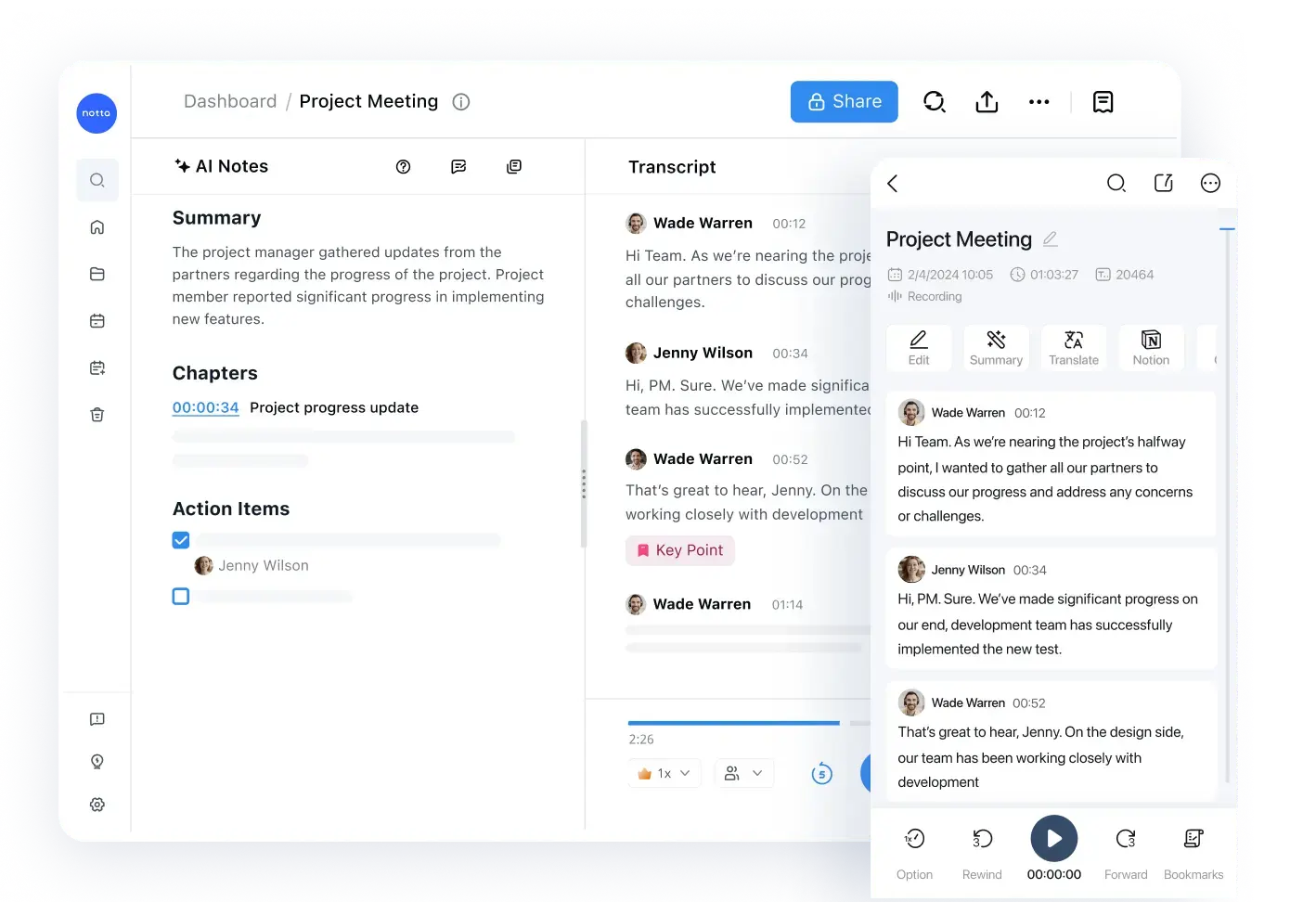
What is Phonetic Transcription & When to Use
Saving time and effort with Notta, starting from today!
Phonetic transcription enhances many business processes by recording accurate and more detailed client, employee, and consumer information from interviews, sales calls, meetings, and much more.
Phonetic transcription is also helpful for businesses with global teams, which now make up about 89% of today’s business teams, because phonetic transcription can help teams understand different language or cultural nuances.
Today, we’re sharing everything you need to know about what phonetic transcription is, when you should use it, and what its biggest limitations are.
What is phonetic transcription?
Phonetic transcription is very different from standard transcription, otherwise known as orthographic transcription. Instead of writing the words as they are traditionally read in the speaker’s language, phonetic transcription records the spoken words as pronounced in the transcription audio using the international phonetic alphabet (IPA).
You may recognize IPA from the last time you looked up a word in the dictionary, which features the IPA spelling below the word. The IPA symbols indicate the phonetic spelling of words. In other words, it spells words out how they are said, not how they are read. Each sound in the word is demonstrated with a unique symbol, which is helpful for those learning the English language or looking up a word they are unfamiliar with.
A few examples of IPA:
Hɛˈləʊ (hello)
ˌɛmplɔɪˈiː (employee)
ˈæpl (apple)
haɪ, haʊ ɑː juː? (Hi, how are you?)
As you can see from the examples above, reading a phonetic transcription to review the basic topics covered in an interview or meeting would be slow going.
However, if you’re looking for the most nuanced transcription that captures how words are said and which words are stressed by the speaker, it can’t be beaten.
Use our cutting-edge AI solution to take control of your tasks and optimize your time and focus.
When should you use phonetic transcription?
Here are a couple of instances when you should use phonetic transcription:
Interview: Phonetic transcriptions can help the interviewer go back and pick up previously missed nuances during the interview. They can also help when interviewing potential candidates whose second language is English or with diverse backgrounds or accents.
Branding: Phonetic transcriptions help your brand be more inclusive, especially to non-native speakers. Brand name pronunciation is a crucial part of customer recognition, so having your entire company, sales representatives, contractors, and marketing professionals aware of how to pronounce your company’s name correctly is crucial.
Sales Calls: Phonetic transcription can strengthen sales calls with international speakers. They can also help B2B business professionals review their pitches and understand their strengths and weaknesses during the call.
Meetings: Many academic and business teams work within global teams. Language differences can make these meetings difficult. However, phonetic transcription provides a clear, supportive language aid for everyone involved.
What are the limitations of phonetic transcription?
Required training: If you’re introducing your team to phonetic transcription, take time to train them on reading IPA and be patient while they learn this new reading style. Different people have varying abilities when it comes to sounding out and understanding phonetics as well. People with specific learning disabilities, like dyslexia, may especially struggle to read IPA, which can be embarrassing for them in a group setting.
Not everyone can understand the transcript easily: Phonetic transcriptions take time and practice to read effectively. Phonetic transcripts require you to sound out each word in your head. An individual unfamiliar with the language may struggle to do this for paragraphs of text, making it difficult for them to understand.
Can not use the transcript directly: Many of us like having transcriptions of meetings, lectures, or calls to reference back to and even create reports and memos from. However, if you want to transform a phonetic transcription into a report or reference, you’ll need to translate the symbols into words, adding more time to the process.
Inconsistencies between phonetic transcriptions: It would be difficult to find a handful of experts to agree that a phonetic transcription is 100% accurate because there is a lot of nuance to recording and creating phonetic transcription. Even within IPA, there are many ways that words can be spelled and still be accurate. This inconsistency is confusing for many.
Get your transcript easier with Notta

Notta is a speech-to-text online converter that frees up your hands, allowing you to pay close attention to meetings, lectures, and sales calls, while transcription is generated for you.
Start by considering how you want to record the meeting, call, or lecture audio for the transcription. For example, if you’re taking a call over Skype or Zoom, look for the built-in record option to record your meeting. Most phones have a built-in recording option, or you can download a free app to record your call.
Take these steps to create a transcription using Notta:
Locate the audio recording, then go to Notta and create a free account.
Go to your Notta Dashboard and click ‘Import Files.’
Find your file and let it finish uploading to Notta, then close ‘Close.’ You’ll now be able to find your transcript within the Notta dashboard.
Click on the transcript to listen to the audio again, make edits to the transcript, and more.
If you want to convert this transcript into a phonetic transcription, we recommend using toPhoenetics, which allows you to paste your English transcript into the tool and shows the IPA phonetic transcription.
Use Notta's AI transcription tool to quickly and easily transcribe audio and videos. We guarantee accuracy and ease of use.
FAQs
What is the difference between phonetic transcription and phonemic transcription?
The difference between phonetic transcription and phonemic transcription is the difference between how a word is pronounced and recorded within the transcription. Phonetic transcriptions indicate how words sound when pronounced. In contrast, phonemic transcription records sound based on what a speaker is trying to communicate and indicates specific stresses that the speaker places on parts of the word.
Is English a phonetic language?
English is not a phonetic language. Since English is not phonetic, certain words within the language are not pronounced the same way that the word is spelled, which can be tricky for individuals learning to speak English.
What is IPA transcription?
IPA transcription, otherwise known as phonetic transcription, uses a particular alphabet of symbols (the international phonetic alphabet) that indicate the different sounds made when pronouncing a word. There are 44 diacritics within the international phonetic alphabet. Each diacritic indicates a different sound, helping readers to understand how a word is pronounced or said within the transcription.
Conclusion
Phonetic transcriptions are an inclusive tool that allows you to reflect on sales calls, meetings, and much more. They also ensure that your entire team pronounces your branding and slogan correctly. However, reading large phonetic transcriptions is a skill that takes a lot of practice to develop and isn’t for everyone.
Learn More